Abstract
Recently, disaster damages have become more widespread due to climate change and the interaction between disasters, and the complexity of solving this problem is increasing. Consequently, many buildings have been severely affected, with some houses being razed or flooded, losing their residential function. The damage to housing facilities not only destroys the life-cycles of individuals and households but also causes functional loss and productivity decrease in local communities. As a countermeasure, the central and local governments provide their citizens with housing facilities, such as temporary housing, to make their lives stable. This study conducted interviews with disaster victims who experienced housing damage from various natural disasters, from the victims of the earthquake in Pohang in 2017 to the landslide in Yecheon and Bonghwa in 2023, and victims who lived in temporary housing between 2017 and 2024 immediately after they suffered such disasters. It then investigated the housing facilities themselves. The study conducted in-depth interviews through one-on-one meetings with the disaster victims directly and their satisfaction levels with their temporary housing facilities were investigated. This study also explored certain issues to be improved on and inconveniences in housing through the statements and experiences of the disaster victims. Based on the interviews, the study identified and gathered the actual problems in and of the housing facilities. Furthermore, based on the results of these investigations, this study developed modular temporary housing units which reflect the various needs and demands of different households. This study contributes to the stability in the living situations of disaster victims. It increases the disaster resilience of the local communities.
1. Introduction
Recently, disaster damages have become more widespread due to climate change and the interaction between disasters, and the complexity of solving this problem is increasing [1]. Consequently, a large majority of buildings are widely affected, and some houses are razed or flooded, losing their function as residences. Disaster victims have difficulties in maintaining a stable life as their houses are damaged. In fact, the damage to the housing facilities not only destroys the life-cycles of individuals and households but also causes functional loss and productivity decrease in the communities. To improve the disaster resilience of local communities and to stabilize the living situation of the victims, the government provides disaster victims with housing facilities, such as temporary housing.
Generally, temporary housing facilities are provided only to the victims of urgent disaster cases, such as those whose house is destroyed or damaged in the disaster-affected area. In the past, temporary housing facilities focused on the functional aspect as a place for urgent evacuation and basic habitation. Temporary housing used to be adopted as a facility to support the basic survival needs of disaster victims. These days, however, temporary housing facilities serve as the starting point of rebuilding the local communities struck by disasters. Beyond the purpose of habitation, these facilities empower the disaster-struck individuals and communities to not only recover from the disaster and restore themselves back to the conditions before the disaster but also empower them to overcome vulnerabilities existing before the occurrence of disasters and to resist disaster damage. Therefore, the support of temporary housing facilities means helping disaster-struck communities maintain disaster resilience.
Housing is related to the disaster resilience of cities, directly or indirectly. Cities consist of a variety of elements, including housing, commercial facilities, and roads, among which housing, as a main element of cities, requires careful management for cities to overcome their vulnerability. Housing recovery for disaster victims is closely connected with the livelihood, health, dignity, and the restoration of their communities [2,3]. Jones. P understands the basic residential space as an urban infrastructure that meets the social and economic needs of the citizens [4]. Ismail, F. Z. et al. have shown that there is a connection between the post-disaster reconstruction of housing and the sustainability and resilience of the cities from the disasters [5]. Also, Tran, T. A. has conducted a case study to identify the factors that increase disaster resilience in housing reconstruction [6]. He argues that the proposals of housing reconstruction for disaster victims and their resilience should consider various factors including socio-economic, institutional, and local aspects. Lee, S. and Lee, S. have investigated the cases where low-income families suffered the same housing damage every year before and after complete restoration and recovery from natural disasters, such as floods and typhoons [7]. In those cases, the victims stated that although they were aware of the importance of housing restoration strategy, it was difficult to improve the restoration itself because of their lack of knowledge on effective house reconstruction and the associated costs. Therefore, temporary housing facilities provided to disaster victims are an essential element to strengthen the resilience of both individuals and community and, from a wider perspective, the local societies and cities. Nevertheless, when disaster victims build their permanent housing, they face many limitations.
Consequently, temporary housing facilities often take the form of transitional housing, ranging from tents to modular or prefabricated structures, mid- to long-term housing, and finally permanent housing [8]. To maintain the normal lifestyles of disaster victims and restore disaster victims to their pre-disaster state, current temporary housing facilities must be cost-effective and multifunctional. Simultaneously, they must be built within a limited budget, taking into account constraints such as residential convenience, construction and transportation, government budgetary issues, and post-construction operational and management difficulties [9]. Davidson, C. H. et al. summarized various discussions that arise in post-disaster housing reconstruction projects [10]. The first issue concerns urban management and disaster recovery methods from a macroscopic perspective, including decentralization of urban governance, urban policy development, and community participation. The second issue concerns negotiations with communities regarding housing supply and disaster relief policies. They emphasize the need for technical capacity and efficient use of limited resources during the construction process, reflecting the priorities of disaster-affected communities [11]. Daniel Félix et al. pointed out that temporary housing, such as tents, container homes, trailer homes, and other temporary structures, may not be sustainable in terms of living conditions and culture [12]. Nevertheless, temporary housing is essential for disaster recovery, as it provides affected households with a place to live and stabilizes their daily lives until long-term reconstruction is completed.
Previous studies explored ways to utilize temporary housing facilities as permanent housing. For example, Wagemann, E. analyzed the temporary housing facilities in Chile and Peru and suggested a solution and guidance to change and utilize temporary housing as permanent ones, regardless of external funding [13]. Askar, R. et al. worked on the process that integrates the temporary housing form and the permanent housing form through a full-scale and prompt provision of housing [14]. Through this, they implied potential sustainability. In addition, Montalbano, G. and Santi, G. suggested prefabricated structures in consideration of the sustainability or economic, social, and environmental impacts of temporary housing solutions [15]. In particular, they divided prefabricated structures into the closed type that includes a washroom and kitchen, etc., and the open type that has separated units, and suggested a low-cost and high-efficiency building process by combining different building materials, such as lumber and corrugated cardboard. These studies attempted to minimize the damage of the disaster sufferers, especially those who lost their houses due to the disasters, by applying various building techniques and processes to the housing solutions. Nevertheless, it appears that the disaster victims who cannot afford permanent housing in the aspects of costs and their life-cycle endure a lower living standard than at the time when they had their own permanent housing.
From a disaster-recovery perspective, housing recovery goes beyond mere physical restoration to include the restoration of victims’ livelihoods, ensuring their dignity and maintaining the community’s recovery and dignity. A long-term housing recovery plan requires the following theoretical characteristics [16]. Housing must, above all, be structurally resilient to potential hazards, manifesting in the form of hurricane-proof roofs and fire-resistant exterior materials. Furthermore, the recovery process must consider environmental sustainability, with solar-power facilities and the use of recycled materials as prime examples of green reconstruction. Housing must go beyond mere survival space to ensure quality of life, embodied in the selection and design of spaces appropriate to the household’s life-cycle. The recovery process must consider factors such as income level, disability status, gender, and age, as recovery conditions can vary depending on individual and household characteristics. Finally, housing recovery must be understood within the context of economic vitality and community interaction. Disaster victims must consider accessibility to work to restore their livelihoods, while also being connected to the revitalization of the local economy. These complex needs lead to the strengthening of transformative capacities that enable victims to absorb the shock of new disasters, maintain a basic standard of living, adapt to changing circumstances after a new disaster, and transform crises into opportunities.
This study aims to improve the problems of temporary housing facilities provided to disaster victims who have suffered residential damage due to disasters. To this end, the study defines the elements of improvement measures for housing recovery from a disaster-recovery perspective. In order to identify these measures, cases of temporary housing facilities applied to domestic disaster victims between 2017 and 2024 were examined. Specifically, the study focused on victims whose permanent housing was damaged by natural disasters such as typhoons, floods, landslides, and wildfires, and who were subsequently accommodated in temporary housing. The investigation of temporary housing included site inspections of the facilities and interviews with disaster victims. Based on the findings, the study presents improvement measures for temporary housing facilities that consider the living convenience of disaster victims. Furthermore, it proposes temporary housing solutions that meet the diverse needs of disaster victims, including housing types and livelihoods, while also considering the sustainability of the temporary housing facilities after residents move out. Accordingly, this study suggests temporary housing that addresses the transitional issues of existing facilities from a disaster-recovery perspective and strengthens the resilience and sustainability of housing during the recovery process.
The current study aims to improve the quality of life of disaster victims by upgrading the existing temporary housing and expanding the functional aspects of this housing through distribution of new modular housing. Adequate per capita living space is a fundamental condition for ensuring the stability of disaster victims and constitutes a factor influencing their resilience to future disasters [17]. This study focused on the distribution and enhancement of modular housing utilized as temporary housing for the following reasons. First, such modular housing is highly time-efficient, as it can be prefabricated, transported, and relocated with relative ease during the post-disaster reconstruction process [18,19]. Second, modular units allow for flexible modifications to accommodate the diverse needs of occupants [20,21]. Modular housing offers the versatility to be combined with additional units for various purposes and supports structural modifications over time [22]. Compared to reinforced concrete, steel-frame, and mixed-structural alternatives, the distribution of modular housing utilized as temporary housing provides superior time efficiency and high scalability, making it a highly suitable option for supporting disaster victims.
This paper consists of the following sections. Section 2 reviews the general status and research efforts about temporary housing facilities. Section 3 investigates the temporary housing facilities and temporary housing installed in the disaster-struck areas in Korea over the last eight years. Section 4 summarizes the findings from the field investigation and suggests modular housing that considers the residential form of disaster victims and includes an improvement proposal.
2. Related Work
Temporary housing facilities, in general, are defined as structures provided to disaster victims and survivors in the areas struck by disasters [23]. They are facilities in which disaster victims live temporarily and receive education and health services, etc. [24]. There are four types of housing used after disasters [2]. The first one is emergency shelter. Emergency shelters provide immediate safe havens for those displaced from their home in emergency situations. Underground parking lots and subway trains, etc., are utilized for this purpose. The second type is temporary shelter. Temporary shelters refer to public shelters provided in the aftermath of a disaster to offer temporary refuge for people displaced by the disaster. Generally, schools, sports facilities, and tents for short-term living are utilized for this purpose for several days or weeks until more refined housing facilities are provided [23]. The third type is temporary housing. Temporary housing units are provided in the form of a modular house or rental apartment. Temporary housing offers a longer period of stay than temporary shelters, and in the case where high-quality living standards are provided, it can be a solution for permanent housing [23]. The last one is housing for permanent residence. Permanent housing should suggest a sturdier structure and better living conditions than temporary facilities and should mean a place that helps disaster victims return to their regular life, such as working and generating profits [25]. Disaster victims either use temporary housing immediately after the occurrence of disaster and then use permanent housing, or use permanent housing directly, skipping the phase of temporary housing. However, it is practically difficult for disaster victims to enter permanent housing directly because of costs and time, as permanent housing takes a longer time to be constructed.
Temporary housing facilities are the minimum means to help disaster victims continue their lives. As mentioned earlier, the types of housing used after disasters are divided into four: emergency shelter, temporary shelter, temporary housing, and permanent housing. Of these, temporary housing facilities encompass emergency shelter, temporary shelter, temporary housing, and permanent housing [2]. Temporary housing facilities are deployed soon after disasters and frequently remain in operation for extended periods. The problems associated with the housing solution as disaster relief include (1) safety, (2) supply, (3) living convenience, (4) consideration for the elderly, (5) harmony with the local community and environment, (6) livelihood and employment, (7) funding, and (8) time to build temporary houses, etc. [26,27]. Of these, the external limitation that requires more consideration is safety against disasters. People who escape disaster move into an emergency or temporary shelter or housing facility, but the place itself may be vulnerable to the disaster [28]. Cajucom, E. P. et al. performed a GIS study on the disaster shelters in Manila and have found out that about 45% of those shelters are located in an area vulnerable to flooding and about 12% are located in a dangerous zone within a fault line [29]. Lagmay, M. and Racoma, B. A. have confirmed that the Manila shelters are at risk of flooding and landslides [30]. Based on such research results, this paper argues that temporary housing facilities should be located in safe areas even after the end of the disaster situation, or the surroundings of the facilities should be well organized to ensure safety.
As for the internal limitations, the most important factors are safety and convenience. Ramos, R. A. et al. investigated the disaster shelters in the Philippines after typhoon Haiyan and concluded that more than half of the shelters did not meet the washroom requirements of the World Health Organization (WHO) [31]. Iwata, T. et al. conducted a study on the construction and the problems of wooden temporary housing, one of the temporary housing facilities built after the 2011 Great East Japan Earthquake and Tsunami [32]. In that study, they compared the maintenance and repair aspects between the wooden facility and other standard temporary houses built without using wood and suggested some improvements to the wooden temporary houses. Their study revealed that wooden temporary houses are vulnerable to breakage due to rain, leakage, and damage to the base, and to the natural environment. In addition, they tried to solve the inconvenience of the disaster sufferers through the satisfaction survey on the temporary housing facilities. Chen, P. T. et al. examined the satisfaction level of the people who lived in temporary housing after the typhoon that occurred in Taiwan in 2009 [33]. Their study revealed that the temporary houses had soundproofing and insulation issues. It also found that in the cases where the temporary houses were built with inadequate design or construction work, it was difficult to improve the living environment of the disaster victims by correcting or repairing the problems. Hong, Y. examined the application of temporary container houses [34]. Hong explains that, compared to steel-frame structure or modular houses, container-type temporary houses are more useful in terms of sustainability as they are easier to assemble and take less time to build. Container-type temporary houses are used and studied in many countries, including The Netherlands and South Korea. However, according to Hong, container-type temporary houses also have several problems, such as the amount of sunshine, ventilation, water, wastewater management, soundproofing, insulation, and view, as well as the issues of reusability or sustainability to be utilized for permanent housing [35]. In this context, the researchers have suggested a method to develop a modular-type structure based on the container houses and have argued the availability of recycling the container-type temporary houses.
Previous studies explored ways to utilize temporary housing facilities as permanent housing. For example, Wagemann, E. analyzed the temporary housing in Chile and Peru and suggested solutions and guidance to change and utilize temporary housing as permanent housing, regardless of external funding [13]. Askar, R. et al. worked on a process that integrates the temporary housing form and the permanent housing form through a full-scale and prompt provision of housing [14]. Through this, they implied potential sustainability. In addition, Montalbano, G. and Santi, G. suggested prefabricated structures in consideration of the sustainability or economic, social, and environmental impacts of temporary housing solutions [15]. In particular, they divided prefabricated structures into the closed type that includes a washroom and a kitchen, etc., and the open type that has separated units, and suggested a low-cost and high-efficiency building process by combining different building materials, such as lumber and corrugated cardboard. These studies attempted to minimize the damage to the disaster victims, especially those who lost their houses due to the disasters, by applying various building techniques and processes to the housing solutions. Nevertheless, it appears that the disaster victims who cannot afford permanent housing in the aspects of costs and their life-cycle endure a lower living standard than at the time when they had their own permanent housing.
Also, temporary housing solutions failed to consider the sustainability of temporary housing from the design stage. In Japan, the recommended use period for temporary housing was two years. Nevertheless, some disaster victims of the Great East Japan earthquake used the temporary housing for three years or more as the restoration work was delayed or permanent housing was not available for them. According to Iuchi, K. et al., after the Great East Japan earthquake that took place in March 2011, the number of residents dwelling in temporary housing was 267,000 [36]. In Korea, the recommended period of temporary housing is one year but, in some cases, people live in temporary housing for a longer period of time. For example, the earthquake victims in Pohang lived in temporary housing for an extended period of time [37].
Therefore, previous studies have categorized the problems of temporary housing into external and internal factors. External factors include persistent lack of site stability and structural vulnerability, while internal issues include inadequate basic living conditions, such as reduced insulation, soundproofing, and convenience. Consequently, some studies have explored ways to improve temporary housing and transition to permanent housing. However, disaster victims facing life-cycle constraints that make permanent housing difficult to build experienced a lower standard of living than permanent housing, and the transitional nature of temporary housing has been largely overlooked. Furthermore, designs predicated on short-term use have failed to consider long-term occupancy and reusability.
This study addresses the challenges inherent in the transitional nature of temporary housing, strengthening it as a core element from a disaster-recovery perspective. The following improvements are proposed. First, we designed detachable and connected modular housing to accommodate diverse family compositions and lifestyles, addressing the issues of flexibility and expandability inherent in existing temporary housing, substantially alleviating the lack of space. This guarantees convenience and privacy for disaster victims, contributing to a better quality of life. Second, we proposed a design that considers the long-term usability of temporary housing. This approach enhances long-term occupancy and functional reusability, laying the foundation for sustainability. Such a design also overcomes the lack of sustainability inherent in the housing design. Furthermore, to our knowledge, very few studies have conducted long-term surveys, collected case studies, and accumulated data over several years to interview disaster victims and improve temporary housing. Furthermore, no existing studies have developed design plans for the distribution of temporary housing based on these improvements. In this respect, this study goes beyond simply presenting problems and developing improvement plans, contributing to strengthening disaster resilience through empirical evidence and long-term analysis.
3. Proposed Methodology
This chapter introduces the methods and research area for field-based empirical research.
3.1. Theoretical Approach and Analytical Framework
Resilience theory originated from the ecological concept of Holling and expanded to encompass socio-ecological dynamics [38,39]. The concept was subsequently adopted and developed into a global policy framework for disaster-risk reduction. The Sendai Framework, at the UN level, proposed “Build Back Better” for international disaster reduction and specified disaster recovery policies [40]. However, in terms of housing recovery, considerations in the immediate post-disaster recovery phase, long-term post-disaster recovery plan, and recovery planning have been consistently studied, but not fully organized [16,41,42,43,44]. This paper categorizes these considerations into three categories, focusing on temporary housing from a disaster-recovery perspective.
The capacities that can be considered in the housing-recovery process within disaster-recovery theory can be broadly categorized into three capacities. The first is the ability to absorb the shock of a disaster. This can be defined as the ability to learn external knowledge and information from shocks, such as disasters, and maintain daily life [16,41]. Absorptive capacity is not a commonly used concept in disaster-recovery theory, but it can be understood as a comprehensive concept that includes elements that build disaster resistance by considering potential factors and installing structural mitigation facilities. This is an element that ensures basic survival and safety by providing minimum facilities immediately after a disaster, thereby recovering from the shock. The second category refers to the ability of victims to return to their daily lives after a disaster [16,42]. The concept of adaptability generally refers to the ability to cope with and manage risks or stress. This capacity refers to the ability to carry out housing recovery so that disaster victims can achieve a qualitative improvement in their housing quality in the medium- to long-term and consider their life-cycle. Finally, there is the ability to transform for the better. Transformative capacity refers to the ability of temporary housing to go beyond restoration to its previous state, ensuring long-term reusability and environmental sustainability, as well as broader community recovery [16,43,44]. This design considers not only short-term use but also mid- to long-term use from the outset. This design improves the overall quality of life for long-term residents and, upon conversion to local public facilities, enables a more advanced recovery system than before the disaster.
Therefore, to address the transitional issues of temporary housing, this study redefines the concepts discussed in existing housing-recovery strategies into absorptive capacity, adaptive capacity, and transformative capacity. Strengthening these elements increases disaster resilience. Figure 1 illustrates the capacities emphasized at each recovery stage from a disaster-recovery perspective.
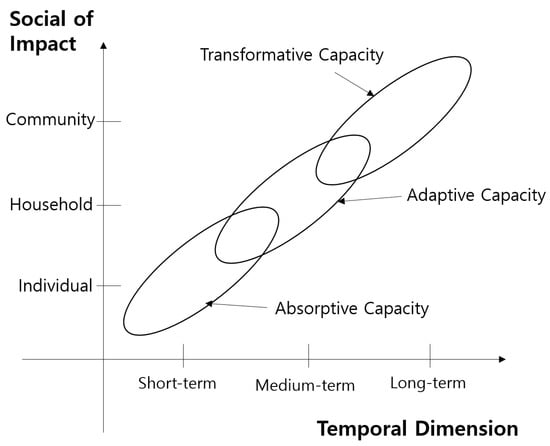
Figure 1.
Temporary housing requirement capacity.
3.2. Overview
This study examined existing cases of temporary housing support in Korea and developed improvement measures based on field surveys of disasters such as earthquakes, heavy rains, and landslides that occurred between 2018 and 2024. Field surveys were conducted through face-to-face interviews with disaster victims living in disaster-stricken areas, and the results were used to identify problems with the temporary housing systems installed in those areas. These interviews included interviews with victims who lost their homes immediately after the disaster, both in their temporary housing facilities and with local officials responsible for disaster relief. Based on the identified problems, the study identified the inconveniences experienced by disaster victims and proposed improvement measures, referencing relevant laws and regulations regarding temporary housing support. Furthermore, based on these improvement measures, the study redesigned temporary housing according to its functional requirements. Figure 2 illustrates the overall process of this study.

Figure 2.
Study process.
In this study, the terms “investigation” and “facility survey” have the following meanings, respectively. First, “investigation” refers to visiting the disaster area and conducting face-to-face interviews with the disaster victims whose homes had sustained significant structural damage or been destroyed. The primary purpose of the interview was to assess the conditions at the disaster site immediately after the event and to collect data on the age, gender, and family composition of the disaster victims, as well as the inconveniences they experienced while residing in temporary housing. The questions are divided into two categories: the function and structural problems of the housing in general, and subjective problems such as individual lifestyle and the number of family members. “Facility survey” refers to the investigation of temporary housing installed at disaster sites. This study examines the inconveniences that the disaster victims experienced, and the damage or functional defects of the temporary housing built in the disaster sites.
3.3. Survey Subjects and Sampling
This study was conducted from December 2017 to June 2024. The survey focused on the areas in Korea with the highest number of displaced persons in each year. To select the subjects, we first identified the residents of temporary housing through administrative and field data. We then contacted all identified victims based on their addresses to conduct a comprehensive survey. Participation was voluntary; those who could not be contacted or who did not express a willingness to participate were excluded. While some cases were excluded from the analysis, we attempted to encompass the entire population to the extent possible. Table 1 describes the disaster types and housing facilities surveyed in this study.

Table 1.
Investigation list by year.
3.4. Field and Facility Survey: Procedures and Analytical Methods
This study conducted interviews based on a semi-structured questionnaire targeting victims living in temporary housing, ranging from the 2017 earthquake to the 2024 landslide disaster. Interviews lasted an average of 40–50 min, maintaining the same question order according to a pre-designed protocol and adding in-depth questions based on respondents’ responses. Semi-structured interviews are highly effective in understanding the perspectives of disaster victims and elucidating the psychological and economic difficulties they experience after a disaster [45,46]. The main questions focused on the inconveniences and improvements experienced by victims in temporary housing. Specifically, the satisfaction survey was structured into five items: (1) overall satisfaction with temporary housing, (2) satisfaction with the interior space, (3) satisfaction with the water supply and drainage facilities, (4) satisfaction with the heating and cooling systems, and (5) satisfaction with insulation. Table 2 shows the questions asked to all of the participants in the interview.

Table 2.
Details of face-to-face investigation.
This study was conducted in compliance with the ethical guidelines of the affiliated research institute, protecting the safety and privacy of the interviewees. Interviews were conducted with prior informed consent for research purposes, and the collected data were processed anonymously. The collected data were initially categorized through open coding, followed by axial coding to label recurring keywords. Categories were then derived through thematic analysis, and these categories were mapped to a theoretical framework based on the elements of absorptive capacity, adaptability, and transformative capacity redefined in this study. To enhance the reliability of the analysis, at least two researchers conducted the interviews and coded the data, and the collected data was peer-reviewed to resolve any discrepancies.
The facility survey was conducted on-site by the same researcher, based on the complaints and concerns identified through semi-structured interviews. The survey items were based on a checklist covering structural stability, water supply and drainage facilities, power supply and heating system malfunctions, insulation and ventilation conditions, and the safety of outdoor spaces and the installation site. All surveys were documented with field notes and photographs. The collected data were cross-checked with victim statements and used to identify recurring complaints or functional deficiencies. Previous studies have mainly relied on resident surveys to measure satisfaction with the living environment and limited themselves to suggesting improvements to facilities, but the research team’s investigation combined victims’ experiential statements with facility inspections to derive the problems of temporary housing in a more empirical and systematic way [33,47,48].
4. Results and Improvements
This chapter presents the major issues identified through field research and discusses improvement measures.
4.1. Survey Results
This study describes the case-analysis results by the type and the year of disaster occurrence. For example, in November 2017, an earthquake occurred in Pohang. The investigation of the Ministry of the Interior and Safety revealed that 92 people were injured and 1792 people temporarily lived in the temporary shelters due to the Pohang earthquake. Afterwards, a total of 200 households and 476 people moved into a rental house or temporary housing, etc. [49].
The housing service at the early temporary shelters was provided to the disaster victims in a form that did not give them separate personal living spaces. The results of the field survey on the indoor shelters, such as the gymnasium or other public facilities, are as follows. Firstly, the air quality was poor due to the over-acceptance of the evacuees and the temperature was not properly managed. Secondly, the relief supplies were intended for adults and thus the children and infants did not receive sufficient supplies. Some victim groups displayed trauma-related symptoms due to the disasters but there was a lack of psychological support programs. Lastly, the support contents for the groups vulnerable to safety, including critically ill patients, pregnant women, the elderly, and children, were lacking. Later, the central and the local governments conducted supplementary work and repair for distributed arrangement and long-term stay of the disaster victims and then provided them with partitions in tent form which could protect their privacy (Figure 3).
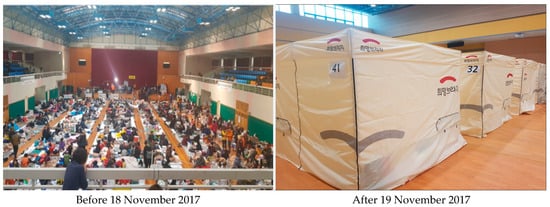
Figure 3.
First-aid temporary shelters.
Then, in December 2017, temporary housing was installed. To check the inconveniences following the change of the season, this study conducted an on-site examination of the temporary housing after eight or nine months’ passing from the housing installation. The target facility of the investigation was 32 units of temporary prefabricated housing that were installed individually, another 32 units of temporary housing installed in a complex, and two types of container housing, 35 units and 15 units, respectively.
This research examined 96 households out of 110. The questions given to them focused on the inconveniences and things that would require improvement in their view. Additionally, the safety and pleasantness of the facility, and adequacy and aesthetic impression, etc., of the space were examined. The results are as follows. First, concerning the inconveniences of the entrance space, of the total respondents, 83.3% pointed out the inconvenience of the entrance space. They mentioned that the containers remodeled for housing purposes were inconvenient, especially when it rained, as they did not have eaves and shoe shelves. Because of that, the disaster victims had to put extra panels under the roof on their own. The disaster victims who lived in the prefabricated temporary housing facility, too, stated that they had experienced difficulties in the case of rain as they had to put their shoes indoors because the eaves were not big enough to provide adequate rain protection. Other inconveniences included no shoe shelves, no eaves or awning, or functional problems thereof, the size of the door, no insect net, story height, and door knobs, etc. Figure 4 illustrates a case in which a displaced person carried out additional construction work. Of the respondents, 69.8% complained about the limited washroom space. In particular, they pointed out the lack of a laundry room, limited space, inconvenient location of the laundry room, and the lack of storage space as inconveniences. Furthermore, about 87.5% said the kitchen sink was inconvenient and about 85.4% said the cooking space was too small. The major inconveniences were the lack of storage space and the overall small space of the housing. In the overall satisfaction survey, this study carried out a survey about the size and the supporting period of the facilities. The levels of satisfaction with the overall facility size were divided into ‘very dissatisfied’, ‘dissatisfied’, ‘neither’, ‘satisfied’, and ‘very satisfied’, and the results of the survey showed that the ratio combining ‘very dissatisfied’ and ‘dissatisfied’ was about 56.1%, which indicated that more than half of the temporary housing residents felt the space was too small. Also, about 73% of the respondents answered that the supporting period of temporary housing facility should be no less than two years.

Figure 4.
The case of additional space construction to prefabricated temporary housing.
Furthermore, this study conducted a facility survey on the temporary housing facilities set up for the disaster victims of the 2019 forest fire and typhoon. The numbers presented first are the results of the forest-fire damage. The fire broke out on 4 April 2019, causing house damage to 566 households and 1289 people [50]. As a countermeasure, 333 units of temporary housing were installed to which 666 people moved. The research team conducted a survey on this housing three times in May, June, and August 2019. The first survey was an on-site examination about the fabrication and installation of temporary housing. The team interviewed the public officials in charge of the installation of the temporary housing on-site. According to them, the most serious problem was uneven housing quality due to the diversification of housing providers. At the second on-site survey, the team found that the eaves or awnings installed in the entrance of the housing were too short to provide adequate rain protection. Also, because the housing was designed in consideration of moving, the floor vibration was noticed on the bottom part of the housing. The lack of eaves gutters caused rain to flow into the living space. In the last survey, the team confirmed that in the case of a group moving in, the housing site was so small that the housing units were too close to one another, causing difficulties in protecting privacy. They also pointed out the lack of insect nets in the houses built in rural or mountainous areas as another problem.
Typhoon Mitag in October 2019 caused flooding to 378 houses and 24.4 hectares (ha) of farmland [51]. This study conducted a survey on the temporary housing site and 14 household victims of the typhoon that occurred in October 2019. Unlike forest fires, typhoons caused damage that weakened the ground around the houses or landslides. Therefore, in the case of typhoon, the study found that it was essential to ensure the safety of the housing site. In some cases, where the housing ground became weak and cranes were used, the structure of the houses bent, or rain leaked into the house. Nevertheless, the research found that a gutter was installed at the eaves, separately, to improve the inconvenience pointed out previously. Moreover, many elderly victims felt uncomfortable using the home appliances as they did not know how to use them. Different than in the case of the previous housing, some cases of the temporary housing distributed in 2019 had interior walls installed in order to divide the space. In such cases, noise and cooking smells from outside could be blocked, but the additional walls might reduce the actual living space of the housing to a certain degree (Figure 5).
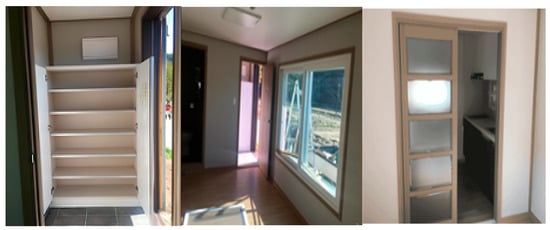
Figure 5.
Interior images of temporary housing.
In September 2020, the research team performed an on-site investigation on 10 households who received the support of temporary housing because of disaster damage from the localized heavy rains occurring in August 2020. In August 2020, heavy rainfall resulted in the provision of 148 temporary housing units [52]. The results of the investigation are as follows. First, the exterior walls were not described minutely enough in the drawing that each constructor built them non-uniformly. Moreover, in the case of installing temporary housing, the height of the entrance threshold was set as 30~40 cm depending on the installation environment, which made it difficult for the elderly to pass through the door (Figure 6).

Figure 6.
Issues surrounding the height of the entrance door threshold.
In 2021, in order to investigate the inconveniences caused by long-term stay at temporary housing of the disaster victims, the research team examined the victims of localized heavy rains that occurred in 2020. Seven households were subject to this investigation. The team found that the residents who experienced inconveniences in moving due to the high entrance-door threshold had installed additional facilities, such as a sloped pathway. The team also found that when the residents moved out from the temporary housing, the base placing to fabricate and install the housing became an issue (Figure 7). In addition, freezing and bursting of the pipes and water leakage were constantly pointed out as problems, and some family members complained that the space was too small.
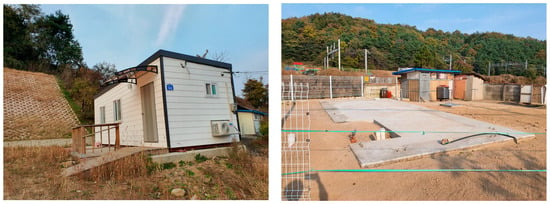
Figure 7.
Issue of the high entrance-door threshold (left) and after-treatment of basic placing (right).
In March 2022, a forest fire broke out again in Gangwon-do, damaging approximately 20,000 ha and affecting 322 houses [53]. After that, the government provided prefabricated temporary housing. The research team of this study investigated it twice in July 2022, about four months after the disaster’s occurrence. The first investigation targeted 20 households and the second one targeted 89 households, totaling 109 households. The results are as follows. The disaster victims answered that they generally stayed at temporary housing for one year or more, and in this context long-term housing support was requested. Also, in the case of the citizens over 80 years of age, they wanted to continue to stay at the temporary housing as it was difficult for them to wait until permanent housing was completed. Similar to the previous study, no eaves or awning in the housing caused inconvenience to the residents. To solve this problem, the temporary housing installed in 2022 had a folding or a fixed-type awning, but the folding awnings showed loose-screw problems. Moreover, in the event that three or more people lived in the house, they felt the space was too small to live in and store things. As for the external environment of the housing installation, it appeared necessary to check the safety in and around the housing location in some cases (Figure 8). Regarding the question about overall satisfaction with the housing, 60% of the respondents answered that they were satisfied, 16% answered that it was neither bad nor good, and 24% answered that they were not satisfied with the housing, which was an improvement from the previous satisfaction rate.
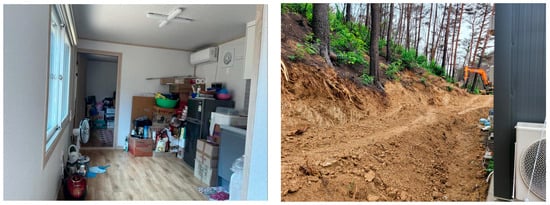
Figure 8.
Things to be improved (left): lack of space; (right): risk of soil erosion and loss).
In the case of the 2022 temporary housing, individually installed facilities still had the issue of high placing, causing inconvenience to the residents. However, in the case of group migration, the basic placing was conducted on a wider ground than in the previous cases, and the floor structures were installed to reduce the inconvenience due to the high entrance threshold (Figure 9).
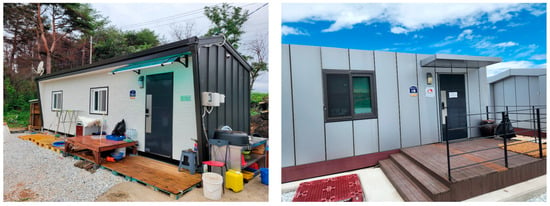
Figure 9.
Entrance inconvenience (left): individual installation; (right): group migration area).
In 2023, Korea experienced localized heavy rains and the resulting damage on multiple occasions. The estimated number of localized-heavy-rain victims from June to September was more than 10,000. In particular, the localized torrents of rain in July caused the loss of lives, including both death and disappearance, and severe house damages. Damage assessments recorded 294 houses that were fully or partially destroyed, 2284 houses flooded, and 68,567 ha of crops damaged [54]. The research team investigated the Bonghwa-gun and Yecheon-gun areas in Gyeongsang-do, which experienced more serious disaster damage and even landslides, causing destruction to the houses and lives of people. The team visited the area four days after a mortality accident and investigated the site before the temporary housing was established.
The investigation results were divided into two categories. First, the temporary housing facilities required some improvements. Until temporary housing was established, disaster victims often stayed at public facilities, such as the gymnasium or community center, for a short period of time. During this process, many victims who stayed at such facilities expressed the inconvenience they felt as there was a lack of shared bathrooms, shower facilities, and laundry facilities. In some cases, the facilities did not even provide first-aid kits to the occupants who moved in at a later time. Second, improvements were required in restoring severely damaged housing areas. In particular, the villages which were completely destroyed by the impact of landslides were expected to take a significantly long time to recover from the disaster. In this context, this study judged that it would be necessary to install a landslide prevention system and arrange divisions for group migration. Figure 10 shows the images of villages completely destroyed.
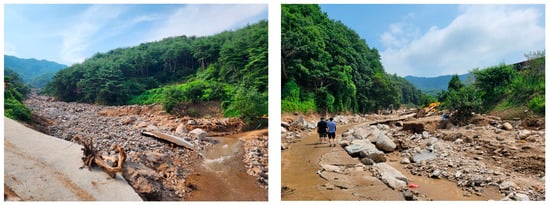
Figure 10.
Cases of damaged village (two places in Yecheon-gun, Gyeongsangbuk-do).
The investigation team of this study visited 10 households in the area where the temporary housing was installed in 2024, right after the heavy rains and landslides in 2023. The total number of households subject to the investigation was 10, the average number of household members was 1.8, and the average age was 63.6. First, to the question of overall satisfaction, 30% answered ‘satisfied’, 60% answered ‘neither’, and 10% answered ‘dissatisfied’. It is meaningful that the dissatisfaction level in the overall impression of the housing was only 10%. To the question of satisfaction with the internal area, 10% answered ‘satisfied’, 50% answered ‘neither’, and 40% answered ‘dissatisfied’. The internal area of the temporary housing provided to the respondents was 2.8 m × 8 m, or about 22.4 m2. For reference, the minimum housing area for the household of two people is 26 m2 in Korea. Most of the respondents were dissatisfied with the internal area, and they answered that the proper number of people to live in temporary housing should be two. As for satisfaction with the water supply and drainage system, 80% answered ‘satisfied’, 10% answered ‘neither’ and 20% answered ‘dissatisfied’. Regarding their satisfaction with the heating and cooling systems, 50% answered ‘satisfied’ and 50% answered ‘neither’ but some expressed their concerns about the costs. As for the satisfaction with home security, 50% answered ‘satisfied’, 30% answered ‘neither’, and 20% answered ‘dissatisfied’. The respondents who said that they were dissatisfied with the security system of the temporary housing lived near the roads, and some of them requested the installation of a window guard. Figure 11 shows cases where a window guard or storage space was added to the initial model either by the temporary housing residents themselves or through the support of private organizations.
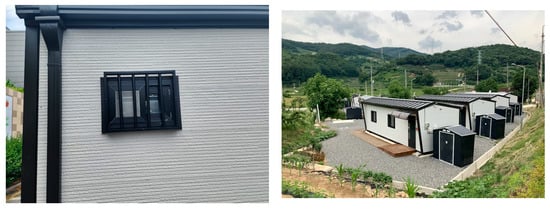
Figure 11.
Cases of inconvenience improvements.
4.2. Temporary Housing Improvements
The research team visited a total of 594 temporary housing units for eight years from 2017 to 2024 in relation to the disasters that occurred in Korea and met with the disaster-struck households for investigation. Many of the interviewees mentioned that the temporary housing provided to the disaster victims of 2017 had an inconvenient entrance pathway as they had no eaves. Additionally, they pointed out the lack of laundry rooms and cooking spaces as the biggest problem. In the 2019 interview, the housing quality, the lack of eaves and too-short eaves were pointed out, and floor vibration and leakage were mentioned as functional problems. After that and until 2024, the overall area of the temporary housing was most frequently and continuously noted as a problem. In particular, the disaster victims who lived in the temporary housing complained that the internal area of the housing was too small and there was a lack of storage space.
This paper addresses the issue of insufficient living space in housing for disaster victims, which is essential for enabling them to recover from disaster impacts and sustain their daily lives. Living space is the most fundamental element that allows victims to return to normalcy and maintain their livelihoods. Accordingly, securing adequate living space constitutes a key factor in enhancing resilience [17,55]. Liu, H. et al. classified resilience into production-space resilience, living-space resilience, and ecological-space resilience, defining 14 indicators for assessing living-space resilience. In their study, per capita living area was identified as the fourth-highest-ranking indicator among the 14, highlighting the importance of spatial adequacy [17]. Alawneh, S. M. and Rashid, M. emphasized that living space has a significant impact on quality of life in creating a resilient environment [55]. Consequently, improvements in the residential environment ultimately enhance the quality of life of individuals and households and increase resilience to disaster impacts [56].
The concrete solution that this study suggests subdivides the existing supporting system and improves the functions of temporary housing in consideration of the household members. The first method of improvement is to design additional modules for temporary housing. In particular, this study proposes a method to provide one additional module for a room (2.8 m × 4 m) to the original unit (2.8 m × 8 m), depending on the number of households, a method to provide a storage space (2.8 m × 2.8 m) if any member of the household does farm work, a method to provide a room and a storage unit together, and a method to remove the washroom in the original unit and instead provide an additional module consisting of only a room and a utility room to the original structure as a method of improvement. Furthermore, this study has drawn up a space-composition proposal for suggested housing types and consulted a qualified architect about the design to review the actual building work and constructability. In this study, four types of temporary housing units were considered based on spatial configuration and purpose:
Type A: Single-room unit.
Type B: Dedicated storage-only unit.
Type C: Combined room and storage unit.
Type D: Unit consisting only of a master bedroom, a secondary room, and a utility space.
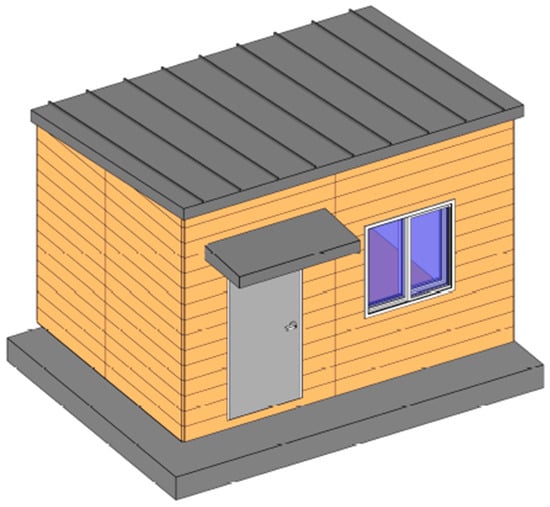
Figure 12.
Type A.
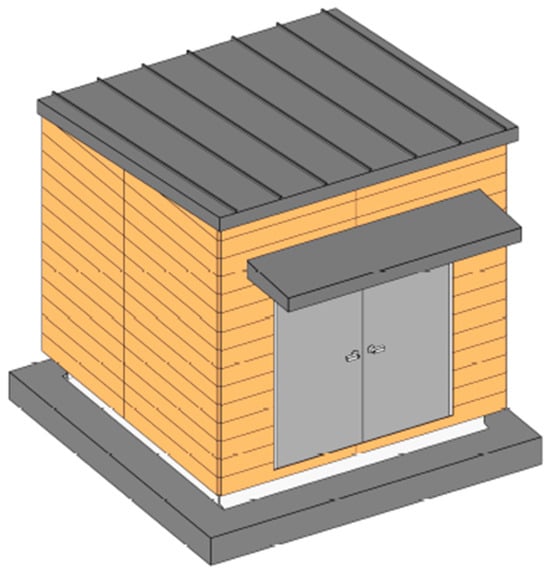
Figure 13.
Type B.
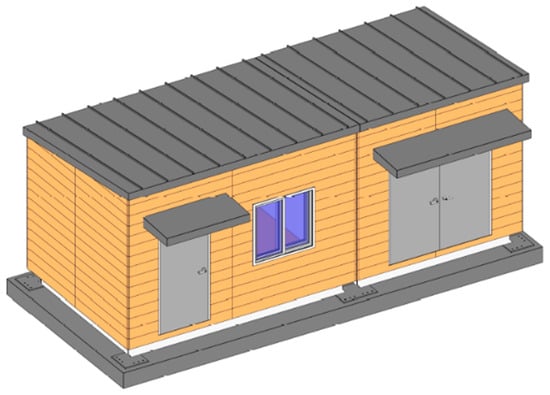
Figure 14.
Type C.
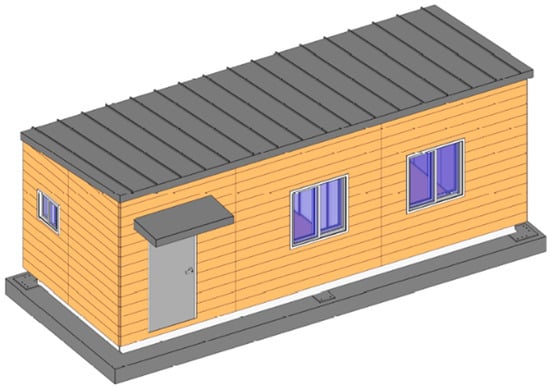
Figure 15.
Type D.
The proposed modular housing units were differentiated into four types according to household needs and functional purposes. Type A is designed as a single-room unit equipped with an entrance area, a shoe cabinet, built-in wardrobes, and basic heating and cooling systems to ensure thermal comfort. Type B functions as a dedicated storage module; it is equipped with electrical facilities but excludes floor heating, reflecting its role as an auxiliary rather than a primary living space. Type C provides an additional room along with a separate storage unit, thereby combining residential and functional needs. Type D is a 2.8 m × 8 m unit designed considering households with a larger number of members; it replaces the bathroom with a multipurpose utility room, thereby increasing flexibility and usability for long-term occupancy. Together, these modular types offer diverse configurations that can be adapted to different family compositions and living requirements. In addition, the proposed modules were reviewed by a licensed structural engineering office to ensure structural safety and insulation continuity, thereby confirming their constructability and suitability for long-term occupancy.
This study focuses on the distribution of housing that can offer specific functions, depending on the members of households, as opposed to the unified temporary housing. In addition, the study has improved the temporary housing by aiming to minimize the inconveniences, especially the inconveniences caused by the small area, reported by the disaster victims. To solve the water-leakage issue in the existing windows, the research team applied self-expanding sealing tapes to address leakage complaints. For the long-term residents, or in the cases where the disaster victim/long-term residents were elderly or lacked financial abilities to rebuild permanent housing, the research team changed the OSB plywood flooring to waterproof plywood flooring to block moisture and prevent twisting in flooring. This contributed to solving the inconveniences most of the long-term residents have experienced.
The field survey results of this study suggest that the recurring deficiencies of temporary housing can be understood as mor than mere inconveniences and redefined as absorptive capacity, adaptability, and changeability from a disaster-recovery perspective. Specifically, issues such as eaves, rain gutters, and site-safety inspections were identified as areas where absorptive capacity could be improved by ensuring minimum comfort and safety. Furthermore, the additional modules (Types A–D) designed to consider household composition and occupation addresses the need for adaptability. Furthermore, the development of standard design documents and the consideration of long-term occupancy and reusability can be understood as enhancing the transformative capacity of temporary housing, transforming it from a transitional facility to a vehicle for local recovery.
4.3. Discussion
Previous studies have improved temporary housing through case analyses based on literature reviews. Perrucci, D. and Baroud, H. conducted a literature review on pre-disaster maintenance of temporary housing, housing construction, and design modeling to enhance the sustainability of temporary housing [57]. Similarly, Abulnour identified key characteristics of post-disaster temporary housing, including rapid availability, utilization of local resources, compatibility with local lifestyles, provision of a planned design life, and optimization of evacuation distances [23]. Approaches to meeting such core characteristics have been described as maximizing “modularity”, which is suitable for meeting specific occupant needs, improving quality of life, and simplifying storage methods [34,58,59]. Literature review-based studies have the advantage of examining a wide range of cases and drawing validated conclusions from years of accumulated research data. However, they face limitations in deriving improvements based on the actual living environments of residents. For instance, strategies for improving temporary housing models have often considered only transportation or inventory management aspects, without constructing housing based on occupant convenience and preferences.
In addition, studies have been conducted to improve temporary housing by deriving enhancement measures from expert panels [60,61,62,63]. Maceika, A. et al. developed specific criteria for improving modular construction projects—covering aspects such as construction time, building lifespan, building components, and energy ventilation systems—and evaluated them using the Delphi method [63]. Such studies have the advantage of collecting opinions from experts in various fields to produce multidimensional improvement plans. However, this approach has a limitation in that it cannot capture inconveniences arising from the actual experiences of residents. The present study addresses this gap by focusing on user experience and considering the continuity of life for disaster victims at both individual and household levels, achieved through the modularization of temporary housing facilities and the expansion of actual living space.
The research team conducted in-person visits to disaster areas and gathered direct feedback from disaster victims. However, the suggestion of the team concerning the improvement of existing temporary housing was directed toward and focused on natural disasters such as forest fires, localized heavy rains, landslides, and earthquakes. Also, most of the household members who were subject to the investigation of this study were the elderly, as well as those who lived not in urban but rural or suburban areas. In sum, the improvement proposal this study has made focuses on specific groups and specific disasters, and therefore further studies are necessary to investigate other types of disaster victims who suffer housing loss or damage.
Furthermore, this study has two limitations. The first is the difficulty of generalization. The study focused on the elderly population in rural areas of Korea. This limits its ability to fully encompass the diverse social classes and living environments of disaster victims. Several studies have explored the improvement of temporary housing. In Japan, temporary housing for disaster victims was provided in small container-type units equipped with a living room, kitchen, and bathroom, with modular units being added as the number of users increased [34]. Another example is the temporary housing used to address the emergency after Hurricane Katrina in 2005 [15]. The U.S. Federal Emergency Management Agency (FEMA) provided mobile homes and travel trailers to accommodate displaced residents. However, residents faced challenges such as limited space, poor interior finishes, and the absence of air conditioning. These cases demonstrate that lack of space and living inconveniences are recurring issues even in international contexts.
The second limitation is that the temporal dimension of temporary housing was primarily explained through qualitative research. Despite examining various disaster cases and victim types over a long period of time, the results do not demonstrate statistically significant changes in housing demand by length of residence or differences in regional contexts. For example, quantitative modeling across various household types, such as elderly households, agricultural households, and multi-generational households, was not conducted. Future research should introduce methodologies such as functional data analysis (FDA) and perform analyses such as function-on-scalar regression to effectively estimate parameters that enhance household resilience [64,65]. Building on the presented qualitative research findings, quantitative evidence should be expanded to provide a more three-dimensional explanation of the relationship between temporary housing and resilience.
5. Conclusions and Future Work
This study examined the needs for improvements after the distribution of temporary housing to the disaster victims who suffered house destruction or damage due to disasters between 2017 and 2024. The research team of this study conducted various on-site investigations, examined the disaster-struck houses, and interviewed the temporary housing residents. Building on these efforts, the study proposed methods to enhance the daily stability of disaster victims by diversifying uniform temporary housing models.
The contributions of this study are anchored in the theoretical framework of disaster recovery. By adopting the perspectives of absorptive, adaptive, and transformative capacities, the study identified the core elements that must be considered in temporary housing. Through long-term field investigations, the study confirmed recurring problems such as insufficient living space, leakage, poor insulation, and accessibility barriers. Based on these findings, the study proposed concrete design improvements—such as modular expansion, functional separation of spaces, and standardized construction details—that provide practical solutions to strengthen resilience in temporary housing.
Future work should extend these findings to urban disaster contexts, where higher density and infrastructure complexity present additional challenges. Moreover, follow-up studies on residents living in the improved modular housing will be necessary to verify whether the proposed model contributes to stability, psychosocial recovery, and resilience outcomes over time. By combining long-term qualitative evidence with potential quantitative approaches, future research can further validate how temporary housing functions not only as a short-term response but also as a key component in building resilience at the household and community levels.
Author Contributions
Conceptualization, J.K. and S.P.; Methodology, J.K., H.K. and S.P.; Validation, J.K.; Formal analysis, J.K.; Investigation, J.K., H.L., D.N., J.S., S.L. and S.P.; Data curation, J.K.; Writing—original draft, J.K.; Writing—review & editing, J.K., H.K. and S.P.; Supervision, S.P.; Project administration, S.P. All authors have read and agreed to the published version of the manuscript.
Funding
This research was supported by the National Disaster Management Research Institute of the Ministry of the Interior and Safety, Republic of Korea (Grant No. NDMI-PR-2025-05-01).
Institutional Review Board Statement
The study was conducted in accordance with the Declaration of Helsinki. Ethical review and approval were not required for this study in accordance with institution and national guidelines, as the survey was conducted anonymously and participation was voluntary. The research was carried out under the multi-year national project procedures of a government-funded program, following the established ethical standards for public research projects.
Informed Consent Statement
All participants in this study provided informed consent prior to participation. The study was conducted in accordance with the ethical guidelines of the affiliated research institute, ensuring the anonymity and confidentiality of responses.
Data Availability Statement
The data presented in this study are available on reasonable request from the corresponding author. Due to privacy and ethical considerations, interview transcripts and personal information cannot be publicly shared. However, design drawings and structural review documents can be provided upon request.
Acknowledgments
This study was conducted with the support of the National Disaster Management Research Institute of the Ministry of the Interior and Safety (“Development of Mega Evacuation Simulation Technology”, “NDMI-PR-2025-05-01”). The authors gratefully acknowledge the assistance received.
Conflicts of Interest
The authors declare no potential conflicts of interest with respect to the research, authorship, and/or publication of this article.
References
- Comfort, L.K. Designing Policy for Action: The Emergency Management System. In Managing Disaster: Strategies and Policy Perspectives; Duke University Press Durham: Durham, NC, USA, 1988; pp. 3–21. [Google Scholar]
- Lines, R.; Walker, J.F.; Yore, R. Progression through emergency and temporary shelter, transitional housing and permanent housing: A longitudinal case study from the 2018 Lombok earthquake, Indonesia. Int. J. Disaster Risk Reduct. 2022, 75, 102959. [Google Scholar] [CrossRef]
- Da Silva, J. Quality and standards in post-disaster shelter. Struct. Eng. 2007, 85, 25. [Google Scholar]
- Jones, P. Housing resilience and the informal city. J. Reg. City Plan. 2017, 28, 129–139. [Google Scholar] [CrossRef]
- Ismail, F.Z.; Halog, A.; Smith, C. How sustainable is disaster resilience? An overview of sustainable construction approach in post-disaster housing reconstruction. Int. J. Disaster Resil. Built Environ. 2017, 8, 555–572. [Google Scholar] [CrossRef]
- Tran, T.A. Post-disaster housing reconstruction as a significant opportunity to building disaster resilience: A case in Vietnam. Nat. Hazards 2015, 79, 61–79. [Google Scholar] [CrossRef]
- Lee, S.; Lee, S. Disaster resilience of low-cost houses: Case study of Thua Thien Hue province, Vietnam. Civ. Eng. Archit. 2017, 5, 141–151. [Google Scholar] [CrossRef][Green Version]
- Davis, I. Shelter after disaster. In Shelter After Disaster; Oxford Polytechnic Press: Oxford, UK, 1978; p. 127. [Google Scholar][Green Version]
- Seo, B.; Yeom, T. A Study on the Improvement Plan for the Practical Use of Inner and Outer-Temporary Housing. J. Soc. Disaster Inf. 2018, 14, 409–420. [Google Scholar][Green Version]
- Davidson, C.H.; Johnson, C.; Lizarralde, G.; Dikmen, N.; Sliwinski, A. Truths and myths about community participation in post-disaster housing projects. Habitat Int. 2007, 31, 100–115. [Google Scholar] [CrossRef]
- Barakat, S. Housing reconstruction after conflict and disaster. Humanit. Policy Group Netw. Pap. 2003, 43, 1–40. [Google Scholar]
- Félix, D.; Branco, J.M.; Feio, A. Temporary housing after disasters: A state of the art survey. Habitat Int. 2013, 40, 136–141. [Google Scholar] [CrossRef]
- Wagemann, E. Need for adaptation: Transformation of temporary houses. Disasters 2017, 41, 828–851. [Google Scholar] [CrossRef]
- Askar, R.; Rodrigues, A.L.; Bragança, L.; Pinheiro, D. From temporary to permanent; a circular approach for post-disaster housing reconstruction. In IOP Conference Series: Earth and Environmental Science; IOP Publishing: Bristol, UK, 2019; Volume 225, p. 012032. [Google Scholar]
- Montalbano, G.; Santi, G. Sustainability of Temporary Housing in Post-Disaster Scenarios: A Requirement-Based Design Strategy. Buildings 2023, 13, 2952. [Google Scholar] [CrossRef]
- Phillips, B.D.; Mincin, J. Disaster Recovery; Routledge: Oxfordshire, UK, 2023. [Google Scholar]
- Liu, H.; Zhu, J.; He, Z. Research on urban resilience assessment and driving forces based on Production-Living-Ecological Spaces: A case study of the Three Gorges Reservoir Area in China. PLoS ONE 2025, 20, e0326770. [Google Scholar] [CrossRef]
- Ghannad, P.; Lee, Y.C.; Choi, J.O. Feasibility and implications of the modular construction approach for rapid post-disaster recovery. Int. J. Ind. Constr. 2020, 1, 64–75. [Google Scholar] [CrossRef]
- Gunawardena, T.; Ngo, T.; Mendis, P.; Aye, L.; Crawford, R. Time-efficient post-disaster housing reconstruction with prefabricated modular structures. Open House Int. 2014, 39, 59–69. [Google Scholar] [CrossRef]
- Garip, E.; Sağlar Onay, N.; Garip, S.B. A model for mass customization and flexibility in mass housing units. Open House Int. 2021, 46, 636–650. [Google Scholar] [CrossRef]
- Magdziak, M. Flexibility and adaptability of the living space to the changing needs of residents. In IOP Conference Series: Materials Science and Engineering; IOP Publishing: Bristol, UK, 2019; Volume 471, p. 072011. [Google Scholar]
- Phillips, D.; Guaralda, M.; Sawang, S. Innovative housing adoption: Modular housing for the Australian growing family. J. Green Build. 2016, 11, 147–170. [Google Scholar] [CrossRef]
- Abulnour, A.H. The post-disaster temporary dwelling: Fundamentals of provision, design and construction. HBRC J. 2014, 10, 10–24. [Google Scholar] [CrossRef]
- Schittich, C. (Ed.) Detail, Small Structures: Compact Dwellings, Temporary Structures, Room Modules; Walter de Gruyter: Berlin, Germany, 2012. [Google Scholar]
- Burnell, J.; Sanderson, D. Whose reality counts? Shelter after disaster. Environ. Hazards 2011, 10, 189–192. [Google Scholar] [CrossRef]
- Ryo, O. Reconstructing Homes in Disaster Regions: Challenges and Support. National Institute for Land and Infrastructure Management and Building Research Institute, 2012. Available online: http://www.nilim.go.jp/english/annual/annual2012/108.pdf (accessed on 13 August 2025).
- Murao, O. Recovery curves for housing reconstruction from the 2011 Great East Japan Earthquake and comparison with other post-disaster recovery processes. Int. J. Disaster Risk Reduct. 2020, 45, 101467. [Google Scholar] [CrossRef]
- Opdyke, A.; Bodo, D.D.; Smyth, J. Higher ground or into harm’s way? Household storm surge sheltering and evacuation plans. Int. J. Disaster Risk Reduct. 2024, 106, 104452. [Google Scholar] [CrossRef]
- Cajucom, E.P.; Chao Jr, G.Y.; Constantino, G.A.; Ejares, J.A.; Quillope, S.J.G.; Solomon, H.M.; Ringor, C.L. Evaluation of the spatial distribution of evacuation centers in Metro Manila, Philippines. Int. Arch. Photogramm. Remote Sens. Spat. Inf. Sci. 2019, 42, 79–85. [Google Scholar] [CrossRef]
- Lagmay, M.; Racoma, B.A. Lessons from tropical storms Urduja and Vinta disasters in the Philippines. Disaster Prev. Manag. Int. J. 2019, 28, 154–170. [Google Scholar] [CrossRef]
- Ramos, R.A.; de Los Reyes, V.C.; Sucaldito, M.N.; Tayag, E. Rapid health assessments of evacuation centres in areas affected by Typhoon Haiyan. West. Pac. Surveill. Response J. WPSAR 2015, 6, 39. [Google Scholar] [CrossRef] [PubMed]
- Iwata, T.; Harada, E.; Maly, E. Towards improving provision of wooden temporary housing: Analysis of repairs of temporary housing built by local contractors after the Great East Japan Earthquake. Int. J. Disaster Risk Reduct. 2023, 86, 103537. [Google Scholar] [CrossRef]
- Chen, P.T.; Yao, G.C.; Yu, C.; Liu, L.F.; Wen, J.H.; Huang, C.H. A comparison of residents’ satisfaction with temporary housing: A case study of two temporary housing types in southern Taiwan. J. Chin. Inst. Eng. 2014, 37, 635–642. [Google Scholar] [CrossRef]
- Hong, Y. A study on the condition of temporary housing following disasters: Focus on container housing. Front. Archit. Res. 2017, 6, 374–383. [Google Scholar] [CrossRef]
- Yoo, H.Y.; Park, Y.J.; Yoon, J.Y. A study on the improving direction of container housing through field survey-based on the analysis of 12 cases in the urban area. J. Korean Hous. Assoc. 2012, 23, 21–30. [Google Scholar] [CrossRef]
- Iuchi, K.; Maly, E.; Johnson, L. Three years after a mega-disaster: Recovery policies, programs and implementation after the Great East Japan Earthquake. Post-Tsunami Hazard Reconstr. Restor. 2015, 29–46. [Google Scholar]
- Kim, S.H.; Kwon, C.Y.; Kim, S.T.; Han, S.Y. Ear acupuncture for posttraumatic symptoms among long-term evacuees following the 2017 Pohang earthquake: A retrospective case series study. Integr. Med. Res. 2020, 9. [Google Scholar] [CrossRef] [PubMed]
- Holling, C.S. Resilience and Stability of Ecological Systems; Cambridge University Press: Cambridge, UK, 1973. [Google Scholar]
- Folke, C. Resilience: The emergence of a perspective for social–ecological systems analyses. Glob. Environ. Change 2006, 16, 253–267. [Google Scholar] [CrossRef]
- Aitsi-Selmi, A.; Egawa, S.; Sasaki, H.; Wannous, C.; Murray, V. The Sendai framework for disaster risk reduction: Renewing the global commitment to people’s resilience, health, and well-being. Int. J. Disaster Risk Sci. 2015, 6, 164–176. [Google Scholar] [CrossRef]
- Cheong, S.M.; Assenova, V.A. Absorptive capacity facilitates adaptation to novel environmental disasters. PLoS ONE 2021, 16, e0259368. [Google Scholar] [CrossRef]
- Jia, H.; Chen, F.; Du, E. Adaptation to disaster risk—An overview. Int. J. Environ. Res. Public Health 2021, 18, 11187. [Google Scholar] [CrossRef] [PubMed]
- Blackburn, S. What does transformation look like? Post-disaster politics and the case for progressive rehabilitation. Sustainability 2018, 10, 2317. [Google Scholar] [CrossRef]
- McClelland, A.G.; Shaw, D.; O’Grady, N.; Fattoum, A. Recovery for development: A multi-dimensional, practice-oriented framework for transformative change post-disaster. J. Dev. Stud. 2023, 59, 1–20. [Google Scholar] [CrossRef]
- Simpson, N.; Pérez, R.; Goldberg, M. Semi-structured interviews on disaster and emergency preparedness for people with disabilities in two states in Mexico. Nat. Hazards 2021, 106, 1037–1064. [Google Scholar] [CrossRef]
- Grimm, A.; Hulse, L.; Preiss, M.; Schmidt, S. Behavioural, emotional, and cognitive responses in European disasters: Results of survivor interviews. Disasters 2014, 38, 62–83. [Google Scholar] [CrossRef]
- KamacI-Karahan, E.; Kemeç, S. Residents’ satisfaction in post-disaster permanent housing: Beneficiaries vs. non-beneficiaries. Int. J. Disaster Risk Reduct. 2022, 73, 102901. [Google Scholar] [CrossRef]
- Mazumdar, S.; Itoh, S.; Iwasa, A. Post-disaster temporary housing: An emic study of lived experiences of victims of the great East Japan earthquake and tsunami. Int. J. Mass Emergencies Disasters 2021, 39, 87–119. [Google Scholar] [CrossRef]
- Ministry of the Interior and Safety. Pohang Earthquake Recovery Costs Confirmed at 144.5 Billion Won. Press Release. 6 December 2016. Available online: https://www.mois.go.kr/frt/bbs/type010/commonSelectBoardArticle.do?bbsId=BBSMSTR_000000000008&nttId=60882 (accessed on 13 August 2025).
- Ministry of the Interior and Safety. The Government, Local Governments, and the Public Will Unite to Restore Damage from the Gangwon wildfires. Press Release. 1 May 2019. Available online: https://www.mois.go.kr/frt/bbs/type010/commonSelectBoardArticle.do?bbsId=BBSMSTR_000000000008&nttId=70447 (accessed on 13 August 2025).
- Ministry of the Interior and Safety. (Immediately) Typhoon Mitag, the 18th Typhoon of the Season, Declared a Second Special Disaster Area. Press Release. 17 October 2019. Available online: https://www.mois.go.kr/frt/bbs/type010/commonSelectBoardArticle.do?bbsId=BBSMSTR_000000000008&nttId=73607 (accessed on 13 August 2025).
- Ministry of the Interior and Safety. Typhoon Mitag, Rapid Support for Temporary Prefabricated Housing for Victims of August’s Torrential Rains. Press Release. 15 August 2020. Available online: https://www.mois.go.kr/frt/bbs/type010/commonSelectBoardArticle.do?bbsId=BBSMSTR_000000000008&nttId=79411 (accessed on 13 August 2025).
- Ministry of the Interior and Safety. The Largest-Ever Recovery Plan for Wildfire Damage in Gyeongbuk and Gangwon Province Has Been Finalized. Press Release. 6 April 2022. Available online: https://www.mois.go.kr/frt/bbs/type010/commonSelectBoardArticle.do?bbsId=BBSMSTR_000000000008&nttId=91426 (accessed on 13 August 2025).
- Ministry of the Interior and Safety. Recovery Efforts are Being Expedited Following the Confirmation of KRW 1.8236 Trillion in Recovery Costs for Heavy Rain and Typhoon Damage. Press Release. 12 September 2023. Available online: https://www.mois.go.kr/frt/bbs/type010/commonSelectBoardArticle.do?bbsId=BBSMSTR_000000000008&nttId=103489 (accessed on 13 August 2025).
- Alawneh, S.M.; Rashid, M. Revisiting urban resilience: A review on resilience of spatial structure in urban refugee neighborhoods facing demographic changes. Front. Sustain. Cities 2022, 4, 806531. [Google Scholar] [CrossRef]
- Barton, C.; Gans, D.; Palmer, R. Beyond temporary: Prototypes for resilient communities. Archit. Des. 2018, 88, 78–85. [Google Scholar] [CrossRef]
- Perrucci, D.; Baroud, H. A review of temporary housing management modeling: Trends in design strategies, optimization models, and decision-making methods. Sustainability 2020, 12, 10388. [Google Scholar] [CrossRef]
- Şener, S.M.; Altun, M.C. Design of a post disaster temporary shelter unit. A/Z ITU J. Fac. Archit. 2009, 6, 58–74. [Google Scholar]
- Ford, G.; Ahn, Y.H.; Choi, D.M. Modular building for urban disaster housing: Case study of urban post-disaster housing prototype in New York. Fire Sci. Eng. 2014, 28, 82–89. [Google Scholar] [CrossRef]
- Zeeman, H.; Wright, C.J.; Hellyer, T. Developing design guidelines for inclusive housing: A multi-stakeholder approach using a Delphi method. J. Hous. Built Environ. 2016, 31, 761–772. [Google Scholar] [CrossRef]
- Bellomo, M.; Colajanni, S.; Campisi, T.; Pons Valladares, O. Multi-Criteria Approach for Assessing the Sustainable Skin for Temporary Housing Modules. In International Conference of Ar. Tec. (Scientific Society of Architectural Engineering); Springer Nature Switzerland: Cham, Switzerland, 2024; pp. 83–98. [Google Scholar]
- Dutta, V.; Singh, V. A Conceptual Plan for Rehabilitation of Disaster-Affected Population in Flood and Cyclonic Regions Using Hybrid Modular Designs. In International Conference on Research into Design; Springer Nature Singapore: Singapore, 2023; pp. 467–480. [Google Scholar]
- Maceika, A.; Bugajev, A.; Šostak, O.R. Evaluating modular house construction projects: A Delphi method enhanced by conversational AI. Buildings 2024, 14, 1696. [Google Scholar] [CrossRef]
- Kokoszka, P.; Reimherr, M. Introduction to Functional Data Analysis; Chapman and Hall/CRC: Boca Raton, FL, USA, 2017. [Google Scholar]
- Fan, Z.; Reimherr, M. High-dimensional adaptive function-on-scalar regression. Econom. Stat. 2017, 1, 167–183. [Google Scholar] [CrossRef][Green Version]
Disclaimer/Publisher’s Note: The statements, opinions and data contained in all publications are solely those of the individual author(s) and contributor(s) and not of MDPI and/or the editor(s). MDPI and/or the editor(s) disclaim responsibility for any injury to people or property resulting from any ideas, methods, instructions or products referred to in the content. |
© 2025 by the authors. Licensee MDPI, Basel, Switzerland. This article is an open access article distributed under the terms and conditions of the Creative Commons Attribution (CC BY) license (https://creativecommons.org/licenses/by/4.0/).